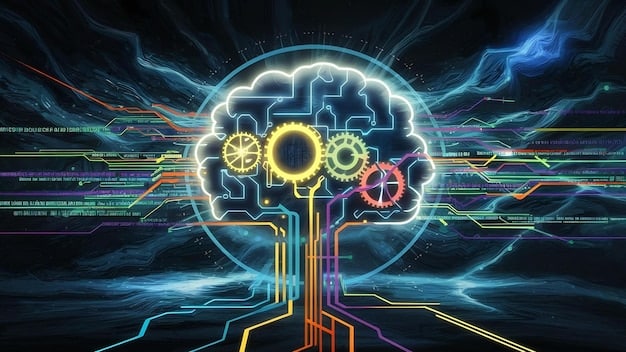Biometrics in the US: Security & Privacy Reinforcement

Biometric technology is rapidly reshaping security and privacy across the US, offering advanced authentication methods that promise enhanced protection for individuals and organizations while navigating complex ethical and practical challenges.
The landscape of security and privacy in the United States is undergoing a profound transformation, driven largely by the exponential growth and adoption of biometric technologies. As digital and physical boundaries increasingly blur, the need for robust, reliable, and convenient authentication methods has never been more pressing. This article delves into The Rise of Biometrics: Enhancing Security and Privacy in the US, exploring its multifaceted impacts, the innovations driving its adoption, and the critical considerations that accompany its widespread implementation.
The Evolving Landscape of Identity and Authentication
The concept of identity has consistently evolved throughout human history, from tribal markings to government-issued documents. In the digital age, validating identity presents a unique set of challenges, particularly given the proliferation of online transactions and interconnected systems. Biometrics emerges as a powerful solution, leveraging unique biological and behavioral characteristics to confirm an individual’s identity with remarkable precision.
Traditionally, authentication relied on what you “know” (passwords, PINs) or what you “have” (keys, ID cards). While these methods have served their purpose, they are inherently vulnerable to theft, loss, or simple human error. Passwords can be forgotten, stolen, or guessed; physical keys can be duplicated. Biometrics introduces a third, arguably more secure layer: what you “are.” This fundamental shift promises a future where identity verification is not only more secure but also significantly more convenient. This convenience translates into faster transactions, reduced friction in accessing services, and a generally smoother user experience across various sectors, from finance to travel.
From Fingerprints to Facial Recognition: A Spectrum of Biometric Modalities
The field of biometrics is diverse, encompassing a wide array of modalities, each with its unique strengths and applications.
- Fingerprint Recognition: A cornerstone of biometric security, widely adopted in smartphones, laptops, and access control systems. Its reliability and ease of integration have made it a popular choice.
- Facial Recognition: Gaining significant traction due to advancements in AI and camera technology, used in everything from phone unlocking to airport security. It offers a contact-less and often seamless authentication experience.
- Iris and Retina Scans: Highly accurate due to the unique patterns in the human eye, often deployed in high-security environments like data centers and government facilities where precision is paramount.
- Voice Recognition: Utilized in call centers and smart home devices, verifying identity based on vocal characteristics. Its hands-free nature makes it appealing for certain applications.
- Behavioral Biometrics: Analyzing unique patterns in how individuals interact with devices, such as keystroke dynamics, gait, and mouse movements. This passive authentication method offers continuous security monitoring.
The choice of biometric modality often depends on the specific security requirements, user convenience needs, and environmental factors of a given application. Organizations typically weigh factors like accuracy, speed, cost, and user acceptance when deploying biometric solutions. The versatility of these technologies underscores their potential to revolutionize security across diverse environments, from the highly secure to the everyday.
Enhancing Security: Beyond Passwords and PINs
The transition from traditional authentication methods to biometrics represents a significant leap forward in bolstering security. Passwords, despite their ubiquity, are a major weak point in most security architectures. They are susceptible to brute-force attacks, phishing schemes, and social engineering. The average user often reuses simple passwords across multiple accounts, creating a domino effect if one account is compromised. Biometrics fundamentally alters this paradigm by moving away from shared secrets to inherent, unique attributes of an individual.
Consider the landscape of data breaches: billions of records compromised annually, often due to weak or stolen credentials. Biometrics offers a more resilient defense. While no system is entirely foolproof, the inherent difficulty in replicating or stealing biometric data far surpasses that of a password. Advanced encryption techniques and secure hardware modules are increasingly being integrated with biometric systems, further fortifying their security posture. This layered approach ensures that even if a biometric template is somehow accessed, it cannot be easily reverse-engineered to reconstruct the original biometric data, let alone be used to impersonate an individual.
Secure Transactions and Access Control: Practical Applications
The practical benefits of biometrics in enhancing security are evident across various sectors within the US. In financial services, biometrics is transforming how consumers interact with their banks, making transactions safer and more convenient. Mobile banking apps often leverage fingerprint or facial recognition for secure login and transaction authorization, significantly reducing the risk of unauthorized access even if a phone is lost or stolen. This not only enhances security but also improves the overall customer experience by streamlining processes and eliminating the need to remember complex passwords or carry physical tokens.
Beyond finance, biometrics is becoming a cornerstone of physical and logical access control. Office buildings, critical infrastructure, and government facilities are increasingly deploying biometric readers to control entry, ensuring that only authorized personnel can access sensitive areas. This enhances security by preventing tailgating and unauthorized access, offering audit trails of who entered and when. On the logical side, biometrics secures access to computers, networks, and sensitive data, protecting intellectual property and classified information from insider threats and external attacks. The healthcare industry is also adopting biometrics for patient identification, ensuring that medical records are accessed only by authorized personnel and accurately linked to the correct patient, thereby enhancing patient safety and data privacy.
The integration of biometric security into everyday life is a testament to its effectiveness. From unlocking a smartphone to boarding an airplane, these technologies are quietly working in the background to provide a seamless yet strong layer of protection. As the technology matures, its capabilities continue to expand, offering even more sophisticated ways to protect valuable assets and sensitive information.
Addressing Privacy Concerns: A Balancing Act
While the security benefits of biometrics are clear, their widespread adoption undeniably raises significant privacy concerns. Unlike a password, which can be changed if compromised, biometric data is immutable; it cannot be reset. This inherent permanence means that if a biometric template is ever stolen or compromised, the individual’s identity could be perpetually at risk. This concern is amplified by the fact that biometric data forms an intimate part of an individual’s unique biological makeup, leading to heightened anxieties about its collection, storage, and potential misuse. Public perception, therefore, remains a critical factor influencing the adoption rate and regulatory framework surrounding biometrics.
The debate often centers on the trade-off between security and privacy. How much personal data are individuals willing to surrender for enhanced security and convenience? This question has prompted extensive discussions among policymakers, privacy advocates, and technology developers. The solutions proposed aim to strike a delicate balance, leveraging the power of biometrics while safeguarding individual rights and autonomy. Transparency in data collection and usage, robust consent mechanisms, and clear guidelines on data retention are essential components of building trust and ensuring responsible biometric deployment.
Data Storage and Biometric Templates: The Technical Safeguards
One of the primary concerns related to biometric privacy is the secure storage of biometric data. It is crucial to understand that most modern biometric systems do not store raw biometric images (like a full fingerprint scan or a facial photograph). Instead, they convert these into irreversible mathematical representations known as “templates.” These templates are then encrypted and stored, often using advanced cryptographic techniques. If a template is intercepted by an unauthorized party, it is designed to be virtually impossible to reconstruct the original biometric data.
Key technical safeguards employed to protect biometric templates include:
- Encryption: Templates are encrypted both in transit and at rest, minimizing the risk of unauthorized access.
- Hashing: One-way cryptographic functions are often used to process biometric data, creating unique hashes that cannot be reverse-engineered.
- Tokenization: Instead of storing the actual template, some systems use tokens that represent the biometric data, adding another layer of abstraction.
- Decentralized Storage: Storing templates in multiple, distributed locations or on the user’s device (e.g., Secure Enclave on smartphones) rather than in a centralized database reduces the risk of a single point of failure and mass data breaches.
- Template Protection Schemes: Techniques like homomorphic encryption or fuzzy extractors allow matching without fully decrypting the template, preserving privacy.
These technical measures are designed to mitigate the risk of data breaches and unauthorized reconstruction of biometric data, ensuring that even if a system is compromised, the sensitive biometric information itself remains secure. The continuous advancement of these protection schemes is vital for fostering public confidence in biometric technologies.

Regulatory Frameworks and Public Policy in the US
The rapid evolution of biometric technology has compelled lawmakers and regulatory bodies in the US to develop frameworks that address its societal implications, particularly concerning privacy. There is no single, overarching federal law governing biometrics; instead, a patchwork of state-specific statutes and sector-specific regulations exists. This fragmented approach can create complexities in compliance and may lead to inconsistencies in consumer protection across different states.
States like Illinois have been at the forefront of biometric regulation, with the **Biometric Information Privacy Act (BIPA)** considered one of the strictest laws in the country. BIPA requires private entities to obtain written consent before collecting or disclosing biometric identifiers or information, and it grants individuals a private right of action to sue for violations. Other states, such as Texas and Washington, have also enacted biometric privacy laws, though generally less stringent than BIPA. At the federal level, discussions continue regarding potential comprehensive privacy legislation that might encompass biometric data, possibly drawing inspiration from international frameworks like the GDPR.
Industry Best Practices and Ethical Considerations
Beyond legislative mandates, many organizations are proactively adopting industry best practices and ethical guidelines to ensure responsible use of biometrics. These practices often go beyond mere compliance, focusing on building user trust and promoting fair data handling. Ethical considerations are paramount given the sensitive nature of biometric data.
Key considerations and best practices include:
- Transparency: Clearly communicating to users what biometric data is being collected, why it’s being collected, how it will be used, and who it might be shared with.
- Consent: Obtaining explicit, informed consent from individuals before collecting their biometric data, with clear options for opting out where feasible.
- Purpose Limitation: Collecting biometric data only for specified, legitimate purposes and not using it for unrelated secondary purposes without new consent.
- Data Minimization: Collecting only the necessary amount of biometric data required for the intended purpose and retaining it only for as long as necessary.
- Security by Design: Integrating privacy and security measures into biometric systems from the initial design phase, rather than as an afterthought.
- Accountability: Establishing clear responsibilities for data protection within an organization and implementing robust audit mechanisms.
- Bias Mitigation: Addressing and mitigating potential algorithmic biases in biometric systems, particularly in facial recognition, to ensure fairness and prevent discrimination across various demographic groups.
These best practices are crucial for navigating the ethical complexities of biometric technologies and fostering an environment where innovation can thrive alongside strong privacy safeguards. Collaboration between industry, academia, and government is essential to develop comprehensive and adaptable frameworks that can keep pace with technological advancements.
Biometrics in the Public Sector: Government and Law Enforcement
The public sector, particularly government agencies and law enforcement, has been a significant adopter of biometric technologies due to their unique needs for identity verification, national security, and public safety. From border control to criminal investigations, biometrics offers powerful tools to enhance efficiency and effectiveness. The US Customs and Border Protection (CBP), for instance, increasingly uses facial recognition at airports to streamline traveler processing and enhance security, verifying identities against travel documents and watchlists. This has demonstrated significant improvements in efficiency and security protocols at points of entry.
Law enforcement agencies utilize a range of biometrics, including fingerprint databases (AFIS – Automated Fingerprint Identification System), facial recognition systems, and DNA analysis, to identify suspects, solve crimes, and track individuals of interest. The FBI’s Next Generation Identification (NGI) system is a prime example of a vast biometric database, capable of processing fingerprints, palm prints, facial images, and iris scans. These tools provide critical leads in investigations and enhance the ability of law enforcement to maintain public order and security. However, their use also raises complex legal and ethical questions about mass surveillance, innocent individuals’ privacy, and the potential for misuse, necessitating stringent oversight and clear guidelines.
Benefits and Controversies: A Dual Perspective
The application of biometrics in the public sector presents a compelling paradox: undeniable benefits juxtaposed with significant controversies.
Benefits include:
- Enhanced National Security: Improved identification of terrorists, criminals, and individuals on watchlists at borders and within critical infrastructure.
- Streamlined Public Services: Faster processing at airports, government offices, and for accessing public benefits.
- Efficient Law Enforcement: Quicker identification of suspects, improved crime scene analysis, and more effective investigative tools.
- Fraud Prevention: Reducing identity theft and fraud in government programs and services.
Controversies and challenges:
- Mass Surveillance Concerns: The potential for widespread, pervasive monitoring of citizens without their explicit consent, leading to erosion of privacy and civil liberties.
- Accuracy and Bias: Concerns about the accuracy of some biometric systems, particularly facial recognition, which have historically shown higher error rates for certain demographic groups, leading to risks of misidentification and disproportionate impact.
- Data Security: The immense amount of sensitive biometric data held by government agencies makes them attractive targets for cyberattacks, raising fears of catastrophic data breaches.
- Lack of Transparency: Public distrust often stems from a lack of transparency regarding how biometric data is collected, stored, and used by government entities.
- Scope Creep: The worry that technologies initially deployed for specific, narrow purposes might gradually expand to broader, less regulated applications.
Navigating these benefits and controversies requires a delicate balance of technological advancement, robust regulatory frameworks, strong ethical considerations, and ongoing public dialogue to ensure that biometric capabilities are utilized responsibly, effectively, and in a manner consistent with democratic values.
Future Trends and Challenges in Biometrics
The trajectory of biometric technology points towards increasingly seamless, ubiquitous, and sophisticated applications. As hardware becomes more powerful and artificial intelligence algorithms mature, we can expect biometric authentication to become an even more integrated part of our daily lives, often operating in the background without explicit user interaction. Innovations in areas like multi-modal biometrics – combining several different biometric modalities for heightened accuracy and security – are on the horizon. For instance, a system might simultaneously analyze a user’s face, voice, and gait to confirm identity, creating a far more robust authentication layer than any single modality could provide.
Further developments will likely focus on passive biometrics, where authentication occurs continuously and imperceptibly as users interact with devices or environments, offering constant security without disrupting the user experience. Consider smart homes or workplaces where biometric systems automatically adjust settings based on who is present, recognizing individuals by their walking style, voice, or even heart rhythm. While these advancements promise unparalleled convenience and security, they concurrently amplify existing challenges and introduce new ones, underscoring the dynamic nature of this field.
Overcoming Adversarial Attacks and Ensuring System Resilience
As biometric systems become more prevalent, so too does the potential for adversarial attacks designed to circumvent them. These attacks can range from sophisticated spoofing techniques (e.g., using high-quality masks or deepfakes to trick facial recognition systems) to presentation attacks (e.g., using artificial fingerprints). Ensuring the resilience of biometric systems against such attacks is a critical area of ongoing research and development. Liveness detection technologies, which verify that the biometric sample is coming from a living person, are becoming increasingly sophisticated to counter these threats.
Challenges in the future also include:
- Digital Identity Integration: Seamlessly integrating biometric authentication with broader digital identity ecosystems, ensuring interoperability across diverse platforms and service providers while maintaining strong security and privacy.
- Standardization: Developing global standards for biometric data exchange and interoperability to facilitate cross-border applications and ensure consistency in data protection.
- Scalability and Performance: Managing and processing ever-growing volumes of biometric data while maintaining high performance, especially in large-scale government and private sector deployments.
- Public Acceptance and Education: Overcoming lingering public skepticism and privacy concerns through transparent communication, robust legal frameworks, and widespread education on the benefits and safeguards of biometric technologies.
- Legal and Ethical Adaptability: Constantly adapting legal and ethical frameworks to keep pace with rapid technological advancements, ensuring that innovation does not outstrip societal safeguards.
Addressing these challenges will require a concerted effort from technologists, policymakers, privacy advocates, and the public, shaping a future where biometrics can fulfill its promise of enhanced security and convenience without compromising fundamental rights.

The Intersection of Biometrics, AI, and Cybersecurity
The rapid advancements in biometric technology are inextricably linked with the parallel evolution of artificial intelligence (AI) and the overarching field of cybersecurity. AI, particularly machine learning and deep learning, forms the backbone of modern biometric systems. These algorithms enable systems to accurately recognize patterns in complex data, such as subtle nuances in facial features, voice patterns, or gait characteristics. AI-powered biometrics can significantly improve accuracy, reduce false positives/negatives, and adapt to variations in user presentation (e.g., changes in appearance over time). This convergence means that biometric systems are not just about capturing a unique identifier, but about intelligent analysis and continuous learning, making them more robust and efficient.
However, this potent combination also introduces new cybersecurity challenges. AI models themselves can be vulnerable to adversarial attacks, where subtle perturbations to input data can trick a system into misidentifying an individual or failing to authenticate a legitimate user. Ensuring the integrity and security of the AI models within biometric systems is paramount, as a compromised model could lead to widespread security failures. The principles of secure AI development, including robust data pipelines, model integrity checks, and explainable AI to understand system decisions, are becoming critical components of biometric cybersecurity.
Building Trust in an AI-Driven Biometric Future
Building and maintaining public trust is perhaps the most significant long-term challenge for the widespread adoption of AI-driven biometrics. As these systems become more powerful and pervasive, concerns about surveillance, algorithmic bias, and the potential for misuse will intensify. A key aspect of fostering trust is ensuring that AI models used in biometrics are fair and unbiased. Historical data used to train these models can inadvertently embed and amplify existing societal biases, particularly affecting recognition accuracy across different racial, gender, or age groups. Addressing algorithmic bias is not just an ethical imperative but a practical security measure; biased systems can lead to security vulnerabilities and perpetuate discrimination.
Furthermore, transparency in how AI-driven biometric systems make decisions, although challenging with complex deep learning models, is crucial. Users and regulators need to understand the logic and limitations of these systems. This includes clear communication about:
- Data Provenance: Where the data used to train the AI models comes from and how it was curated.
- Performance Metrics: Regular publication of system accuracy rates across diverse populations.
- Explainability: Efforts to make AI decisions more interpretable, even if simplified for public understanding.
- Human Oversight: Ensuring that human judgment and intervention remain integral to high-stakes biometric decisions, especially in law enforcement.
- Auditing and Accountability: Establishing independent auditing mechanisms to assess system performance, identify biases, and ensure compliance with ethical guidelines.
The future of biometrics in the US hinges on the industry’s and government’s ability to responsibly integrate AI while proactively addressing privacy concerns, mitigating biases, and cultivating an environment of trust through transparency and strong ethical governance. This collaborative effort will shape whether biometrics becomes a universally accepted tool for security and convenience or remains a point of contention.
| Key Area | Brief Description |
|---|---|
| 🔒 Enhanced Security | Biometrics offer stronger authentication than passwords, reducing fraud and unauthorized access in vital sectors like finance and government. |
| 👁️ Privacy Concerns | Immutable nature of biometric data raises privacy issues, necessitating robust encryption and responsible data handling practices. |
| 📜 Regulatory Landscape | Fragmented US laws (like BIPA) guide biometric use, with ongoing discussions for comprehensive federal privacy legislation. |
| 🚀 Future Trends | Advances in AI and multi-modal systems promise seamless user experiences, alongside challenges like adversarial attacks and public trust. |
Frequently Asked Questions About Biometrics
▼
The most common types include fingerprint recognition, facial recognition, iris scans, and voice recognition. Each method leverages unique biological or behavioral characteristics for identity verification. Newer modalities like behavioral biometrics, analyzing key patterns in user interaction, are also gaining traction for continuous authentication.
▼
Biometrics are inherently more secure than passwords because they rely on unique personal attributes that are difficult to replicate or steal. Unlike passwords, which can be forgotten, guessed, or phished, biometric data, when properly secured, offers a much stronger layer of identity verification, significantly reducing the risk of unauthorized access and fraud.
▼
Yes, privacy concerns are justified because biometric data is immutable and linked directly to an individual’s identity. If compromised, it cannot be changed like a password. This necessitates robust technical safeguards, strong encryption of templates (not raw data), and clear legal frameworks to prevent misuse and ensure responsible data handling, building public trust.
▼
AI, particularly machine learning, is crucial for improving the accuracy and efficiency of biometric systems. AI algorithms help analyze complex patterns in biometric data, enhancing recognition capabilities and reducing errors. It also enables advanced features like liveness detection to prevent spoofing and supports the development of sophisticated multi-modal biometric solutions.
▼
Key challenges include developing more resilient systems against sophisticated adversarial attacks and addressing ethical concerns about surveillance and algorithmic bias. Establishing comprehensive regulatory frameworks and achieving widespread public acceptance through transparent practices and education on data protection are also paramount for future growth and responsible deployment.
Conclusion
The Rise of Biometrics: Enhancing Security and Privacy in the US presents a compelling narrative of technological progress interwoven with profound societal implications. From fortifying cybersecurity defenses to streamlining everyday interactions, biometric technologies offer transformative potential. However, their pervasive adoption also casts a critical light on the delicate balance between security imperatives and fundamental privacy rights. As we look ahead, the continued evolution of biometrics will hinge not just on technological advancements, but crucially on the development of robust ethical guidelines, adaptive regulatory frameworks, and genuine transparency in how this deeply personal data is handled. Ultimately, the success of biometrics in shaping a more secure and convenient future in the US will be measured by our collective ability to harness its power responsibly, fostering innovation while rigorously protecting individual autonomy and trust.





